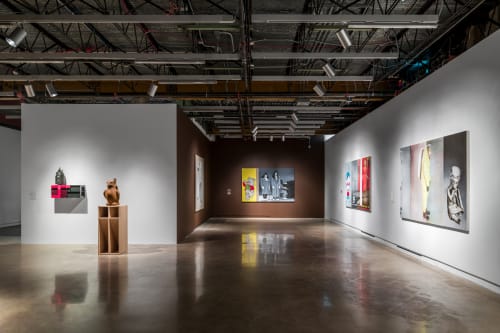“Playful,” “mischievous,” “poetic,” “subversive”—these are the terms that Heather Pesanti, chief curator at the Contemporary Austin, reaches for in describing “The Sorcerer’s Burden: Contemporary Art and the Anthropological Turn.”
Opening Sept. 14 at the museum’s two Austin, Texas, locations, the exhibition presents works by 11 artists who borrow, riff on and critique anthropology and its methods, such as field work and documentary filmmaking. The artists “all lean toward the experimental,” favoring “open-endedness and uncertainty rather than concrete answers,” Ms. Pesanti said. “They’re touching on anthropological areas but pulling them back into the art world through fiction.”
The show fills the museum’s building in downtown Austin and extends to its sculpture park at Laguna Gloria. At the museum, visitors first encounter Nathan Mabry’s sculptures—geometric, minimalist-inspired boxes topped by meticulous replicas of pre- Columbian Moche vessels, which feature realistic portrait sculptures, or West African helmet masks. These striking cultural mashups pose questions that echo through the show: “Whose culture is it, who has the right to talk about things, who has the right to use images, when is it appropriate?” as Ms. Pesanti put it.
Nearby paintings by Julia Wachtel push appropriation into pop-culture territory, pairing images from magazines or the internet in humorous but unsettling combinations—the lead character from “Breaking Bad,” for instance, matched with a cartoon figure peeping through a keyhole. Ms. Wachtel’s work “points out the affinities that art has with visual anthropology,” which studies and critiques images, said Ms. Pesanti. “Taking a lens that one might bring to anthropology but using it on the internet and pop culture.”
In other works, historical research sparks unexpected interpretations. The sleek abstract sculptures of Kapwani Kiwanga’s “Glow” series (2019) were inspired by 18th- century “lantern laws” that, as a means of surveillance and control, required unaccompanied slaves in some northern U.S. cities to carry lanterns after dark. By contrast, Ms. Kiwanga’s “Flowers for Africa: Ivory Coast” (2015) is a floral arrangement—arrived at by a local florist replicating, via the artist’s written instructions and an archival image, an arrangement that had been part of the backdrop during a key moment in Ivory Coast history: the ceremonial exchange of documents between French and Ivorian officials in 1960, marking the sovereignty of the newly independent nation.
The museum’s second-floor galleries spotlight artists who tackle intimately familiar topics. The main characters in Ed Atkins’s digitally animated videos are “melancholy British blokes—of which he is one,” said Ms. Pesanti. Though his works are created with CGI technology, she added, “they’re talking about culture and beliefs in very social- anthropological ways.” Ruben Ochoa’s photographs of ficus-tree roots breaking through the sidewalks of his childhood Los Angeles neighborhood reflect the tug of war between nature and urban construction, as well as the disparities of wealth and class that leave these broken pavements unrepaired.
Like Mr. Atkins, Ghanaian-born Nuotama Bodomo invests imaginative storytelling with a field anthropologist’s sensibility. Her 2014 video “Afronauts” investigates a little- known aerospace program that had been launched in Zambia in the 1960s and envisions an alternate ending: While the actual program remained earthbound, in Bodomo’s video a Zambian rocket, carrying a teenage female astronaut, soars off into the stratosphere. “You can read the label, and it will say that it’s fictive, but when you’re watching it, it reads like a documentary,” Ms. Pesanti said. Each of the works in the show, she noted, “is flirting with this ambiguity between fact and fiction.”
Four projects commissioned by the Contemporary Austin will debut in “The Sorcerer’s Burden.” Among them are two video installations, Dario Robleto’s “The Boundary of Life Is Quietly Crossed” (2019) and Theo Eshetu’s “Adieu Les Demoiselles” (2019). Mr. Eshetu’s work reconsiders the appropriation of African art and culture by Pablo Picasso and his modernist colleagues. Taking Picasso’s iconic 1907 “Les Demoiselles d’Avignon” as a starting point, Mr. Eshetu placed performers before a projected image of the painting, filming them as they posed as the figures in Picasso’s work and improvised their own movements. He then fragmented this imagery, collaging it with additional material from other modernist artists—a way of expanding and shifting the conversation around primitivism, appropriation and art.
Two of the show’s commissions are sited at the Laguna Gloria sculpture park. “Trap and Weir” (2019), an installation by Marie Lorenz, combines steel forms resembling lobster traps with ceramic vessels reminiscent of ancient octopus traps. Sited on an old concrete boat dock at the edge of Lake Austin, the work is a sly wink not only at anthropology but at archaeology, placing ancient-looking devices for catching saltwater creatures on the shore of a freshwater lake. The other Laguna Gloria commission, Cameron Jamie’s “Mon Singe” (2019), also takes a freewheeling approach, in this case to ritual figures and totems. Sculpted in clay, then cast in bronze, Mr. Jamie’s life-size, near-abstract figure—whose title translates as “My Monkey”—has an artless air and a seeming affinity for simian mischief.
